| Komodo dragon Temporal range: Pliocene - Holocene,[1] 3.8–0 Ma | |
|---|---|
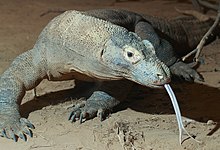 | |
| Individual at Cincinnati Zoo | |
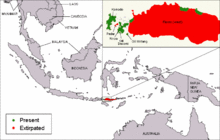 | |
| Komodo dragon distribution |
The Komodo dragon[4] (Varanus komodoensis), also known as the Komodo monitor, is a species of lizard found in the Indonesian islands of Komodo, Rinca, Flores, Gili Motang, and Padar.[5] A member of the monitor lizard family Varanidae, it is the largest living species of lizard, growing to a maximum length of 3 metres (10 ft) in rare cases and weighing up to approximately 70 kilograms (150 lb).[5]
Their unusually large size has been attributed to island gigantism, since no other carnivorous animals fill the niche on the islands where they live.[6][7] However, recent research suggests the large size of Komodo dragons may be better understood as representative of a relict population of very large varanid lizards that once lived across Indonesia and Australia, most of which, along with other megafauna, died out after the Pleistocene (likely as a result of human activity).[1] Fossils very similar to V. komodoensis have been found in Australia dating to greater than 3.8 million years ago, and its body size remained stable on Flores, one of the handful of Indonesian islands where it is currently found, over the last 900,000 years, "a time marked by major faunal turnovers, extinction of the island's megafauna, and the arrival of early hominids by 880 ka [kiloannums]."[1]
As a result of their size, these lizards dominate the ecosystems in which they live.[8]Komodo dragons hunt and ambush prey including invertebrates, birds, and mammals. It has been claimed that they have a venomous bite; there are two glands in the lower jaw which secrete several toxic proteins. The biological significance of these proteins is disputed, but the glands have been shown to secrete an anticoagulant. Komodo dragons' group behaviour in hunting is exceptional in the reptile world. The diet of big Komodo dragons mainly consists of Timor deer, though they also eat considerable amounts of carrion.[5] Komodo dragons also occasionally attack humans.[9]
Mating begins between May and August, and the eggs are laid in September. About 20 eggs are deposited in abandoned megapode nests or in a self-dug nesting hole.[5]The eggs are incubated for seven to eight months, hatching in April, when insects are most plentiful. Young Komodo dragons are vulnerable and therefore dwell in trees, safe from predators and cannibalistic adults. They take 8 to 9 years to mature, and are estimated to live up to 30 years.[5]
Komodo dragons were first recorded by Western scientists in 1910.[10] Their large size and fearsome reputation make them popular zoo exhibits. In the wild, their range has contracted due to human activities, and they are listed as vulnerable by the IUCN.[2] They are protected under Indonesian law, and a national park, Komodo National Park, was founded to aid protection efforts.
...
Komodo dragons were first documented by Europeans in 1910, when rumors of a "land crocodile" reached Lieutenant van Steyn van Hensbroek of the Dutch colonial administration.[11] Widespread notoriety came after 1912, when Peter Ouwens, the director of the Zoological Museum at Bogor, Java, published a paper on the topic after receiving a photo and a skin from the lieutenant, as well as two other specimens from a collector.[3]The first two live Komodo dragons to arrive in Europe were exhibited in the Reptile House at London Zoo when it opened in 1927.[12] Joan Beauchamp Procter made some of the earliest observations of these animals in captivity and she demonstrated the behaviour of one of these animals at a Scientific Meeting of the Zoological Society of London in 1928.[13] The Komodo dragon was the driving factor for an expedition to Komodo Island by W. Douglas Burden in 1926. After returning with 12 preserved specimens and 2 live ones, this expedition provided the inspiration for the 1933 movie King Kong.[14] It was also Burden who coined the common name "Komodo dragon."[15] Three of his specimens were stuffed and are still on display in the American Museum of Natural History.[16]
The Dutch, realizing the limited number of individuals in the wild, outlawed sport hunting and heavily limited the number of individuals taken for scientific study. Collecting expeditions ground to a halt with the occurrence of World War II, not resuming until the 1950s and 1960s, when studies examined the Komodo dragon's feeding behavior, reproduction, and body temperature. At around this time, an expedition was planned in which a long-term study of the Komodo dragon would be undertaken. This task was given to the Auffenberg family, who stayed on Komodo Island for 11 months in 1969. During their stay, Walter Auffenberg and his assistant Putra Sastrawan captured and tagged more than 50 Komodo dragons.[17]The research from the Auffenberg expedition would prove to be enormously influential in raising Komodo dragons in captivity.[18] Research after that of the Auffenberg family has shed more light on the nature of the Komodo dragon, with biologists such as Claudio Ciofi continuing to study the creatures.[19]
Etymology
The Komodo dragon is also known as the Komodo monitor or the Komodo Island monitor in scientific literature,[4] although this is not very common. To the natives of Komodo Island, it is referred to as ora, buaya darat (land crocodile), or biawak raksasa (giant monitor).[20][11]
Evolutionary history
The evolutionary development of the Komodo dragon started with the genus Varanus, which originated in Asia about 40 million years ago and migrated to Australia, where it evolved into giant forms (the largest of all being the recently extinct Megalania), helped by the absence of competing placental carnivorans. Around 15 million years ago, a collision between Australia and Southeast Asia allowed these larger varanids to move back into what is now the Indonesian archipelago, extending their range as far east as the island of Timor. The Komodo dragon was believed to have differentiated from its Australian ancestors 4 million years ago. However, recent fossil evidence from Queensland suggests the Komodo dragon actually evolved in Australia before spreading to Indonesia.[1][21] Dramatic lowering of sea level during the last glacial period uncovered extensive stretches of continental shelf that the Komodo dragon colonised, becoming isolated in their present island range as sea levels rose afterwards.[1][11] Extinct Pliocenespecies of similar size to the modern Komodo dragon, such as Varanus sivalensis, have been found in Eurasia as well, indicating that they fared well even in environments containing competition such as mammalian carnivores until the climate change and extinction events that marked the beginning of the Pleistocene.[22]
Description
In the wild, an adult Komodo dragon usually weighs around 70 kg (150 lb), although captive specimens often weigh more.[23] According to Guinness World Records, an average adult male will weigh 79 to 91 kg (174 to 201 lb) and measure 2.59 m (8.5 ft), while an average female will weigh 68 to 73 kg (150 to 161 lb) and measure 2.29 m (7.5 ft).[24] The largest verified wild specimen was 3.13 m (10.3 ft) long and weighed 166 kg (366 lb), including undigested food.[11]
The Komodo dragon has a tail as long as its body, as well as about 60 frequently replaced, serrated teeth that can measure up to 2.5 cm (1 in) in length. Its saliva is frequently blood-tinged, because its teeth are almost completely covered by gingival tissue that is naturally lacerated during feeding.[25] It also has a long, yellow, deeply forked tongue.[11] Komodo dragon skin is reinforced by armoured scales, which contain tiny bones called osteodermsthat function as a sort of natural chain-mail.[26][27] This rugged hide makes Komodo dragon skin a poor source of leather.
Komodo dragons have long been great zoo attractions, where their size and reputation make them popular exhibits. They are, however, rare in zoos because they are susceptible to infection and parasitic disease if captured from the wild, and do not readily reproduce.[20] As of May 2009, there were 13 European, 2 African, 35 North American, 1 Singaporean, and 2 Australian institutions that kept Komodo dragons.[72]
The first Komodo dragons were displayed at London Zoo in 1927. A Komodo dragon was exhibited in 1934 at the National Zoo in Washington, D.C., but it lived for only two years. More attempts to exhibit Komodo dragons were made, but the lifespan of these animals was very short, averaging five years in the National Zoological Park. Studies done by Walter Auffenberg, which were documented in his book The Behavioral Ecology of the Komodo Monitor, eventually allowed for more successful managing and reproducing of the dragons in captivity.[18]
A variety of behaviors have been observed from captive specimens. Most individuals are relatively tame within a short time,[73][74] and are capable of recognising individual humans and discriminating between familiar keepers.[75] Komodo dragons have also been observed to engage in play with a variety of objects, including shovels, cans, plastic rings, and shoes. This behavior does not seem to be "food-motivated predatory behavior".[8][11][76]
Even seemingly docile dragons may become unpredictably aggressive, especially when the animal's territory is invaded by someone unfamiliar. In June 2001, a Komodo dragon seriously injured Phil Bronstein, the then husband of actress Sharon Stone, when he entered its enclosure at the Los Angeles Zoo after being invited in by its keeper. Bronstein was bitten on his bare foot, as the keeper had told him to take off his white shoes and socks, which the keeper stated could potentially excite the Komodo dragon as they were the same colour as the white rats the zoo fed the dragon.[77][78] Although he escaped, Bronstein needed to have several tendons in his foot reattached surgically.[79]



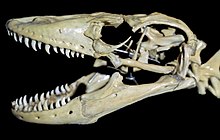
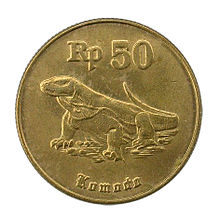

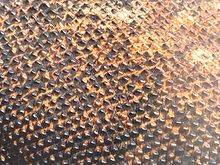

No comments:
Post a Comment